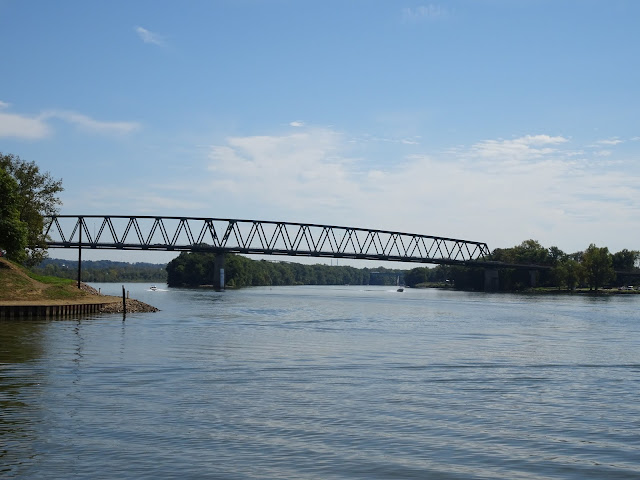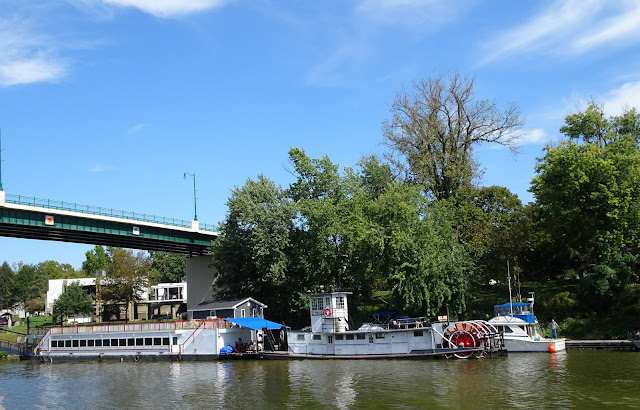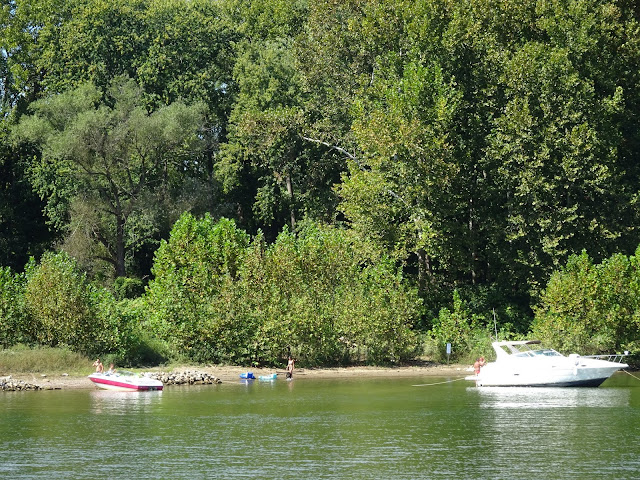 |
| Looking down on the New River Gorge from the interstate. |
 |
| The resort has a lodge, swimming pools, several restaurants, an Arnold Palmer signature golf course, hiking trails, biking trails, and a beautiful RV park right on the lake. |
 |
| In the distance is the RV park where many locals bring their rig and boat and spend the weekend on the lake. |
 |
| A large walking bridge carries you over one section of the lake where the lodge and other amenities are located. |
 |
| Boat tours are also available. |
 |
| The lake is very large so the pups were able to get in for a swim during their daily hikes. |
Other than the resort and the state park there isn't much to do in the area. There was one major attraction in the nearby town of Weston which was a few miles away. It is considered one of the top attractions in all of West Virginia so we decided to drive into Weston and check it out.
 |
| The part of Weston we visited is the old part of town that has been through some tough times. |
 |
| There were a few historic homes and businesses. |
 |
| But for the most part, the main attraction is what brings tourists into this part of town. |
 |
| This is the Trans-Allegheny Lunatic Asylum. |
The hospital was authorized by the Virginia Assembly in the early 1850's. They allocated $125,000 to build the asylum on 269 acres along the West Fork River opposite downtown Weston. Using a philosophy called "Moral Treatment", they theorized that buildings designed to admit abundant light and air could help cure patients.
It is the largest hand-cut stone masonry building in North America. It has 242,000 square feet over four floors, is 1,296 feet long, and has 921 windows and 906 doors. The walls are two and a half feet thick with a 200-foot tall clock tower stretching up through the center that still works today.
Construction began in 1858 but was interrupted by the outbreak of the American Civil War.
 |
| This section was the first part of the hospital that was completed before the Civil War began. |
Following its secession from the United States, the government of Virginia demanded the return of the hospital's unused construction funds. Before this could occur, the 7th Ohio Volunteer Infantry seized the money from a local bank and delivered it to Wheeling. It was put towards the establishment of the Reorganized Government of Virginia, which sided with the northern states during the war. The Reorganized Government of Virginia eventually became the state of West Virginia in 1863.
 |
| This building, once the psychiatric unit, was used to house people with tuberculosis. Today they use it as a haunted house each fall. |
 |
| Some of the reasons you could be committed to the Trans-Allegheny Lunatic Asylum. |
 |
| Many sections of the hospital have not been restored yet but the owner has completed some floors. |
 |
| Plaster falling off the walls is one of many problems. |
 |
| A picture of a patient wing when the hospital was still in operation. |
 |
| The nurse would stay in this room with a window to oversee what the patients were doing. The hospital was often under-staffed. |
 |
| A typical room for a single patient if the hospital wasn't so overcrowded. |
 |
| Wood blocks on the walls used as handrails to help the infirm. |
 |
| A gathering room in one of the wards. |
 |
| An operating room. |
 |
| An x-ray machine. |
 |
| The morgue. |
 |
| The asylum building is made of of many different sections and connected by long hallways. It would be so easy to get lost in this place. |
 |
| The second floor landing to the doctor's quarters. |
 |
| The doctor also had his own study. |
 |
| And a library. |
 |
| Down the hall was an apothecary for the doctor. |
 |
| The nurses had their quarters on the third floor but they had to share the rooms with other nurses. |
 |
| Most were two to a room. |
 |
| I guess if you are middle aged, single, and homely this is a pretty good gig. |
 |
| The red moulding you see is not made of wood. It is plaster created by artisans. |
 |
| This large room of the insane asylum was used for parties and dances by the people in the community. |
Occasionally they had a get-together for the people inside the hospital and this is a quote from one of the patients who was allowed to attend.
|
 |
| You can see these faces on many of the outside columns. The inmates thought the faces brought them good luck. |
 |
| The front lawn of the insane asylum with the town of Weston in the distance. The tour was interesting, but sad, and I would never want to take it again. |
We moved on to another part of the state and wound up in Marietta, Ohio, which is just across the Ohio River from West Virginia. The reason we stayed here was because there weren't any RV parks on the WV side.
 |
| Crossing the Ohio River to Marietta. |
 |
| Along the Muskingum River are paddle wheel boats for touring or to take a trip down the river. |
For many years the Ohio River overflowed its banks and flooded the town until in 1929 a series of locks and dams were built to help control the water flow in the river. Markers along the river show how high the water rose during several devastating floods.
 |
| The poles represent the height of flooding that happened in Marietta. The highest was 60.3 in 1913 but even in 1937 the waters rose to 55 feet. |
 |
| This mural painted on one of the downtown buildings replicates a photo of the flooded front street in January, 1937, with a student from Marietta College rowing down it in a boat. |
 |
| The Barber House was built in 1829 for Levi Barber, a surveyor, merchant, and U.S. Congressman. |
 |
| Views from the Barber House where the Muskingum and Ohio Rivers meet. |
 |
| The walking bridge. |
 |
| Downtown Marietta across the river. |
 |
| More lovely old homes with a stellar view. |
 |
| We found this Gothic Revival home in another area of Marietta. It is called 'The Castle' and was built in 1855 by Melvin Clarke, a lawyer who died in the Civil War at Antietam. |
 |
| Nearby we saw other beautiful old homes and across the street from the homes is the Mound Cemetery. |
Mounds and earthworks were created between 800 B.C. and 700 A.D. by prehistoric Moundbuilders who were the first farmers and artisans in the Ohio Valley and Marietta is the site of a Moundbuilders city. The mound was where they buried their chieftans.
Marietta was also the first white settlement in the Northwest Territory under the leadership of Rufus Putnam. The pioneers were officers and soldiers of the American Revolution who received land grants for their service. Many of those soldiers were buried here beside the ancient inhabitants.
 |
| Tombstones of the early pioneers with the ancient burial mound in the background. |
 |
| There are steps leading to the top of the mound where you can look down to the cemetery below. |
 |
| A listing of some of the Revolutionary soldiers who are buried in the Mound Cemetery. |
 |
| These flags and markers honor Revolutionary soldiers who were buried in Washington County, Ohio, but their graves are unknown. |
Our final adventure was to take an excursion on a riverboat down the Ohio River.
 |
| It was a warm, sunny day and the upper deck was covered offering us a grand view. |
 |
| The mighty Ohio River. |
 |
| The historic Lafayette Hotel on the Ohio River. The white colored brick shows the height of the water from the 1913 flood. |
 |
| The path in front of the name is where voyagers on riverboats would land and walk up to visit the town of Marietta. |
 |
| The Ohio River has all kinds of activity. |
 |
| There are many islands in the middle of the Ohio River and over the years the land has been deeded to the state and turned into wildlife refuges. |
 |
| The paddle wheel created a rainbow as we rode down the river. |
 |
| Newer homes along the river with wonderful views. |
We had an enjoyable stay in Marietta learning about its heritage and seeing some wonderful sights. Now back to West Virginia to head further north and find other adventures.
Peace !














































No comments:
Post a Comment